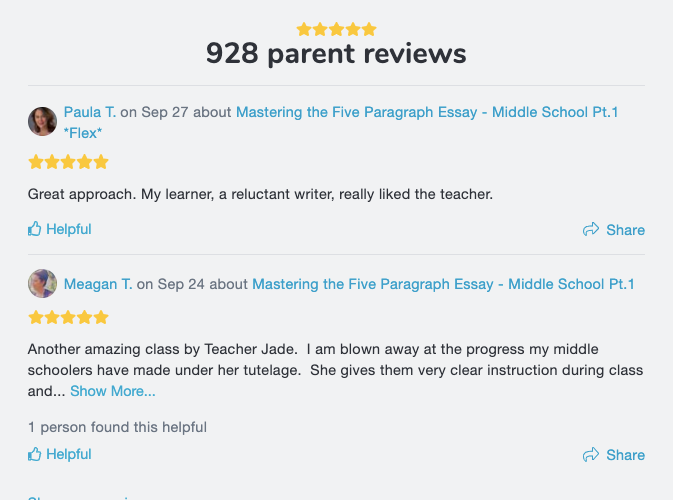How to help your child make the most of an online classroom
During our recent Back to Outschool Live event, Outschool teacher Jade Weatherington shared her expertise on distance learning, and how to facilitate the best possible experience between teachers, parents, and learners.
Jade is a veteran online teacher and tutor, with more than 10 years of online teaching experience. Over two and a half of those years have been with Outschool, where her classes on reading, writing, and education have earned over 900(!) parent reviews.

Jade also has experience teaching in traditional public schools, and she began teaching online as her own children transitioned to homeschooling.
Highlights of Jade's presentation, shared below, are valuable for families who are new to online learning, families with experience who want to maximize its benefits and for teachers looking to create the best possible experience for their learners.
Overall, much of Jade's advice comes down to two essential behaviors: establishing clear expectations and maintaining open communication.
Navigating the classroom to create a positive experience
Work with your child to locate online classroom features, tools, and functions, which can differ across platforms.
One of the major differences in an online classroom is getting used to the platform that hosts the experience. Even if you as a parent are new to online learning, it is helpful for you to learn all of the basic functions of the platform your learner will be using.
On Outschool's How to prepare for your first class page, you can learn the 6 steps we suggest you take to make sure you and your learner are ready for your live online class over Zoom.
6 steps to help your learners have a great first class on Outschool
- Watch our 2-minute video on tips for your first class
- Download Zoom (click here to download)
- Watch a basic Zoom tutorial
- Test Zoom
- Prep for class by reviewing the Learner Code of Conduct, checking your learner's webcam, finding a quiet place for class and gathering any required materials
- Go to your classroom by clicking "schedule," finding and clicking on your class title, selecting the "classroom" tab, and clicking "join live meeting"
For more information on preparing for your first class, read the full guide here.
Determine how learners communicate with the teacher
Some teachers only use the platform that hosts the class for communication, while others have a preferred app to use for communication, such as email. Also, be sensitive to teacher response times, which are often outlined in class descriptions or introductory materials.
On Outschool, parents may send messages through private conversations with the teacher, or by posting on the learners tab, which is not private. Some teachers may decide to respond back through conversations to keep communication private between teachers and parents.
Understand how learners can safely communicate with each other
Learners can become friends during live online classes, and teachers can help facilitate this process safely. When this happens, it's important for parents to be aware of the best practices for maintaining safety and privacy while participating in an online class.
For example, if two learners are developing a friendship during an online class, one learner may ask the teacher if the other learner is willing to share his or her email address.
(Related: Read about the two teens who sparked an in-real-life friendship after meeting in an Outschool class.)
Important rules & expectations in a virtual classroom
Some teachers set policies around communicating in an online classroom, and learners may also have their own preferences or needs for how they communicate, too.
In general, it's important for parents to learn the expectations and needs for their learners when it comes to three methods of communication in the online classroom.
- Audio: teachers may mute all learners to prevent background noise. They also may have their own ways to facilitate in-class discussion to maintain order and make space for everyone to participate.
- Camera/video: for the safety of teachers and learners, it's essential that learners turn their camera on so teachers can verify that only kids attend class. However, we do accommodate shy learners when possible.
- Chat: in general, learners should use the chat for class-related questions or class discussion. Like in a physical classroom, off-topic messages in the chat can be distracting to other learners and the teacher.
Types of Classes
Similar to a traditional classroom, teachers approach their online classes in varying styles. Your goals and your learner's preferences may align with particular styles of classes, and it can be helpful to look for information about the structure of the class in the description or by asking the teacher directly before class begins.
Popular formats for online classes include:
- Lecture: teachers present information to learners through a mixture of speaking and presenting multi-media resources
- Discussion: teachers may present some information to learners, and then pose questions and prompts to learners to encourage them to talk about class topics
- Mixture: teachers integrate elements of both lecture and discussion-style classes
- Student led/Teacher led: some teachers have clear outlines for their entire class curriculum as well as each daily class session, while other teachers encourage and use learner input to guide the scope of the class
None of these class styles are necessarily better than another. However, you and your learner may have a better experience if your expectations for your online class match the approach that the teacher plans to take.
Best practices for parents when communicating with their children's online teachers
Share important information about your learner
If your child has learning differences or requires accommodations, such as those outlined in an IEP or 504 plan, it is important to share this information with the teacher.
For example, in a writing class, some learners might use the text-to-talk function instead of the keyboard to compose their writing. If the teacher is aware of this, then they will know why the learner is muted or has the camera off during a writing activity.
Keep in mind, not all online teachers come from a formal teaching background. This means that parents may need to explain some of the specific modifications or accommodations that a learner requires. It's best to provide this information to teachers before classes begin, so teachers have adequate time to make the changes needed to support your learner.
Inquire about feedback and assessment
Feedback is the response that the teacher gives to the learner about their ideas and work in a class. It may include the teacher describing their observations about the learner's work, or suggestions and advice for how the learner can improve their work.
Ensuring a good online learning experience means getting clear about a teacher's policies, and matching those to the expectations of you and your learner.
Ask the teacher about the kind, frequency, and medium for feedback in the class. Some learners may prefer receiving lots of feedback and advice on their work, while others may have different preferences.
Again, ensuring a good online learning experience means getting clear about a teacher's policies, and matching those to the expectations of you and your learner.
What parents should know about teachers developing live online courses
Some, not all, teachers will share class materials
Teachers have varying policies on sharing their class materials. Please be mindful of all of the time and effort that teachers put into creating class materials, and recognize that some teachers prefer to limit access to source files for this reason.
Most teachers will welcome your suggestions
If your learner loves a class, don't be afraid to suggest to share that feedback with the teacher. This may inspire the teacher to create a part two of a class, or it might encourage the teacher to create a class on a related topic.
When making suggestions or class requests, please again be mindful of the time required for teachers to develop high-quality classes.
Ultimately, communication between teachers and parents is key to creating the best experience for your teachers' online classrooms. At the start of an online learning experience, teachers and learners do not know each other, so the more information parents can provide the teacher, the better the learning experience can be.
When the teacher has all the information they need to best teach your child, and you've aligned you and your learner's expectations to those of the teacher, you can rest easy in the comfort that your learner is getting the best experience available.

